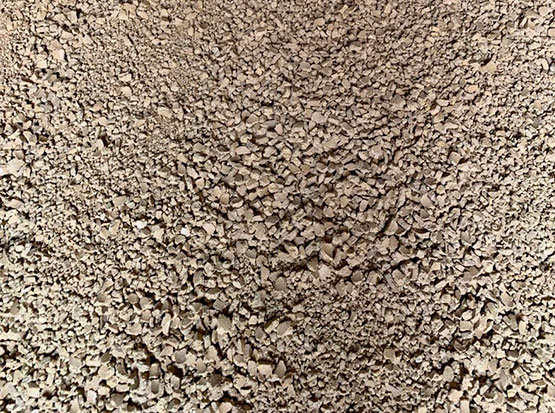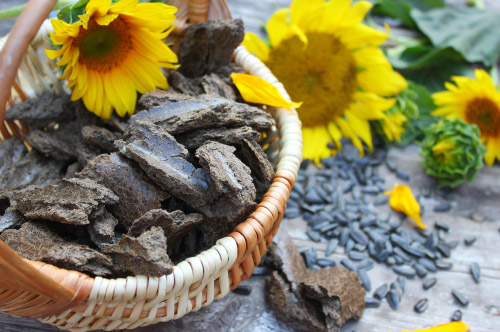
In terms of its nutritional value and the amount of essential amino acids, lysine, tryptophan, glycine, and choline, and the amino acid composition, soybean meal takes a leading position along with such highly nutritious products as feed yeast, fish and meat and bone meal. Soybean meal is much more superior to the meals of other oilseed crops in terms of the content of feed units and the amount of protein.
Soybean grist and meal are obtained by processing soybean grain using different techniques. In the technological scheme for oil extraction for the production of grist, the extraction method is used, while in the production of meal, extrusion-press processing is used. At the same time, meal and grist differ in the degree of oil being extracted from soybeans. If before processing the soybean grain contained 20-25% of oil, then after its separation, 6-10% remains in the meal (depending on the equipment used and technology modes), and 1-2% in the grist.
Processing of soybean seeds into feed and food grist at oil extraction plants is carried out without preliminary mechanical removal of oil by extracting the raw petal with a solvent (gasoline or alcohol). This scheme makes it possible to obtain grist with a given ratio of soluble and insoluble proteins. Extracting oil from soybean seeds by direct solvent extraction, due to the insufficient thermal effects during the extraction process, does not sufficiently reduce the content of antinutrients, which necessitates the use of additional treatments of the grist. The meal obtained by extrusion followed by cold pressing is significantly different, where the solubility indicators are identical to those of the grist, and in some cases exceed the grist in this important indicator. To summarize, it is important to note the following: meal obtained by extrusion and cold pressing is a much more valuable product than grist obtained in the traditional way using intensive moisture-heat treatment and a high-octane solvent (light gasoline).
Soybean meal is preferred in feeding breeding chickens and fattening pigs due to the following reasons:
Adding soybean meal (with a high content of linoleic and linolenic acids) to the diet of laying hens helps to increase egg production, produce eggs of the required weight and increase the poultry’s resistance to diseases. By adding meal to feed, cows can increase milk yield by 20% and milk fat content by 0.03%.
In terms of nutritional value and chemical composition, soybean meal has the best performance of all feeds and meal of other crops. There are 1.2 feed units per kg of product in soybean meal; for comparison, in rapeseed – 0.98; flax – 1.14; sunflower – 0.98; castor bean – 0.59; meat and bone meal – 0.87; fish meal – 1.05; feed yeast – 0.91. In terms of the amount of digestible protein, soybean meal also has the best indicators among other types of feed additives – 345.5 g per kg of feed, in castor bean, sunflower, flax, rapeseed – 310; 325.4; 265.5; 277.3 grams per kg of product, respectively.
The use of soybean meal makes it possible to achieve high weight gain and low production costs in poultry and livestock farming. This product is the most valuable high-protein component of feed for the following groups of animals: poultry, pigs, cattle.

To enrich feed with energy in the preparation of feed mixtures and dry food for pigs, cattle, chickens, turkeys, ostriches, cats, dogs and other animals.
Due to its lecithin content, soybean oil has a beneficial effect on brain function. A large amount of choline, saturated and unsaturated acids, vitamins and minerals determines its ability to have a preventive and therapeutic effect in diseases of the cardiovascular system, liver, and kidneys.
Soybean oil is convenient to use, since it can be added to dry food, to bind it and make it easier for animals to eat, to reduce losses, since the oil binds small particles of crushed food and dry ingredients and does not allow them to fly out during transportation and mixing. In addition, in this form the feed takes on a more compact shape
Feed production enterprises use it as an energy carrier. Greater efficiency is observed for laying hens, and the size of eggs increases..
In recent years, soybean oil has also been used to feed beef cows to increase their growth potential. Soybean oil as a pure vegetable fat is a rich energy feed. It contains 35.5 mg IU, almost 3 times more energy than barley. The addition of 1-3% soybean oil leads to the desired increase in caloric value and improved taste, along with a positive effect of binding dry ingredients.
In pig farming, soybean oil is of great importance. With the help of soybean oil in the diet, it is possible to convert essential fatty acids directly into body fat. Namely, first of all, this can be done with unsaturated butyric acid and doubly unsaturated vital linoleic acid, which are not formed by themselves in the animal’s body, and therefore can only be supplied with food
To increase productivity, soybean oil is added to feed mixtures for sows and for feeding young animals. Energy-rich feed mixtures for sows from about 2 weeks before farrowing until the end of the nursing period and before supplementation with soybean oil supplements provide the following benefits: increasing value of the sow’s milk; higher fat content in milk; higher percentage of body fat in piglets at birth; more intensive weight gain of piglets; reducing the weight loss of the sow during feeding; dynamic development after weaning of piglets
For young animals, the need for high-quality nutrition is very important; already in the first days of life, piglets are able to absorb fats. Soybean oil, based on its optimal fatty acid composition, has particularly high digestibility.
Feed for piglets without dust and with a high caloric value with 2-6% of soybean oil is readily accepted by piglets from the 3rd-4th day of life and provides undeniable advantages, higher daily weight gain, rapid achievement of marketable weight, which increases the efficiency of breeding piglets by several times.
The "Stimul" Company offers high-quality meal of its own production from extruded soybeans (non-GMO!) obtained by cold pressing at an affordable price. An individual approach is applied to each customer. The products have all the necessary permit documents
If you have any questions, please contact us at the number 8 (919) 286-62-87

Sunflower oil is one of the most important vegetable oils with a wide range of applications.
Raw sunflower oil obtained by pressing has a pleasant smell and taste.
For the production of oils, unique modern equipment is used, which allows the preservation of all the beneficial properties, while all offered products comply with standards and regulatory and technical requirements.
All products are supplied with a declaration of conformity, quality certificate, veterinary certificate (on request), quarantine certificate (on request).
Our company’s priorities:

Sunflower meal is obtained by squeezing oil from seeds. Essentially, these are the remains of seeds that were compressed during the extraction of oil from them. The meal is produced in the form of: pressed slabs, shells
The quality of the meal as feed is determined by the type of sunflower seeds and the process of obtaining oil from them.
Sunflower meal has a rich composition:
There are vitamins A, B, E. 1 kg of product contains: up to 14 mg of pantothenic acid, 0.3 mg of carotene, up to 48 mg of nicotinic acid, 6-9 mg of riboflavin, 13 mg of thiamine.
The meal contains a lot of proteins and fats, which makes it beneficial for agricultural animals. It has a high energy value and a low degree of oxidation, so this supplement allows animals and birds to fill up faster.